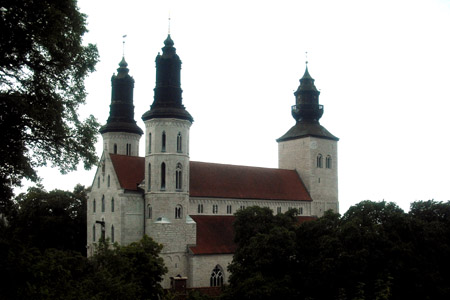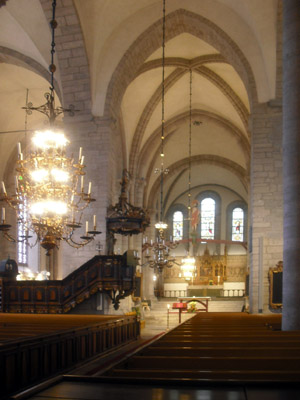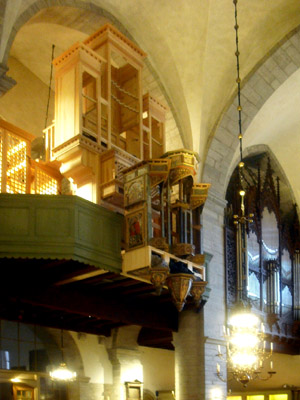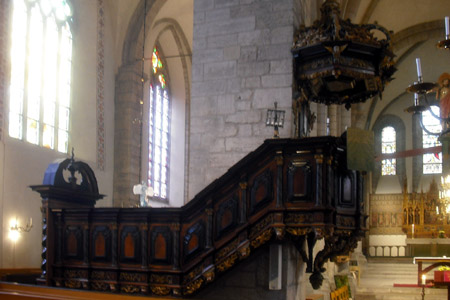| |
 |
 |
 |
| Comment on this report, or find other reports. |
 |
| Our Mystery Worshippers are volunteers who warm church pews for us around the world. If you'd like to become a Mystery Worshipper, start here. |
 |
| Find out how to reproduce this report in your church magazine or website. |
|
|
| 3068: Sankta Maria Domkyrka, Visby, Sweden |
 |
 |
 |
Mystery Worshipper: Teutonic Knight.
The church: Sankta Maria Domkyrka (St Mary's Cathedral), Visby, Sweden.
Denomination: Svenska Kyrkan (Church of Sweden). The Church of Sweden is one of the largest Lutheran denominations in the world and is part of the Porvoo Communion, which has full interchangeability of ministries with the Church of England, not merely eucharistic communion.
The building: Its origins go back to the late 12th century. It was built for the German merchants who passed through this busy port, the required fee being used to finance construction. Sankta Maria is the only one of the city’s many medieval churches that survives intact. It is built of Gotland limestone, with the internal staircases in the tower being made of wood. The only major restoration work was carried out around 1900 and again in the late 20th century, when a big north chapel was added. This chapel now seems mainly to be functioning as a porch with a bookstall, and it is the place where coffee is served after mass. However, it also has an altar and organ. No medieval stained glass survives, nor do most of the original furnishings. A 12th century statue of the Queen of Heaven has been replaced by a modern replica, but the statue of the Risen Christ atop the rood beam is the original, with flaky paint from the 13th century. The polished limestone font is the biggest in Gotland and lined with copper. The pulpit dates from the 17th century. It sports a quadruple hourglass sermon-time, and a wooden carved Spirit Dove suspended from the sounding board.
The church: Sankta Maria was consecrated as a cathedral in 1572, and today it serves the Diocese of Visby, which includes all Swedish churches and congregations abroad as well as the island of Gotland. It is also the parish church for the walled city. There are groups for all ages, plus visitors' and seekers’ groups. There are a number of choirs. Apart from Sunday mass they have different acts of worship during the week – they strive to have rich worship with something for everyone.
The neighbourhood: Visby is the capital of Gotland, a large island off the east coast of mainland Sweden in the Baltic. It was one of the Hanseatic trading ports and an important stop en route to and from Russia. It still has its medieval town centre with cobbled streets and layout, and an almost entirely intact 13th century city wall with dry moat and defensive towers. The island once had 100 medieval churches, all built by local craftsmen and financed by the islanders without extra levying of taxes by the Church or Crown. Ninety-two of these are still consecrated. An extraordinary amount of original wooden sacred art of this period survives on the island, unlike in the rest of Reformation Europe. The island seems to be big on festivals: in addition to Organ Days (see below), they put on a Politicians Week and a Crime Week (which was just beginning as we left), as well as a Medieval Week commemorating the Battle of Visby 1361, when the townspeople of Visby paid a ransom to King Valdemar IV of Denmark to keep the Danes from sacking the city (they plundered a church or two anyway).
The cast: The celebrant was Biskop Sven-Bernhard Fast, Bishop of Visby. The preacher was the Rt Revd Michael Ipgrave, newly appointed bishop of the Anglican Diocese of Lichfield. Three more priests were in the procession: two unnamed Swedish priests as well as an unnamed Anglican priest. Also part of the procession were young acolytes and a crucifer as well as several adult laypersons, all unrobed. The guest organist was Randi Elisabeth Mortensen, organist of St Canute's Cathedral, Odense, Denmark. Each year Gotland sponsors a summer organ festival, at which the public may hear guest organists primarily from Scandinavian and Baltic countries playing several of the island's historic organs at a variety of concerts and services.
The date & time: Thirteenth Sunday after Trinity, 21 August 2016, 11.00am.
Comment:
We have received a comment on this report.
What was the name of the service?
Högmässa (High Mass) – but see below.
How full was the building?
I was 15 minutes early and it seemed empty. However, it filled up quite nicely. There was a large international ecumenical party of about 50 people who were having a conference in Visby over the weekend and who seemed to fill half the church. There were also a number of summer visitors, both Swedish and foreign. I guess a comfortable 230+ or so in total. I saw only two children, apart from the three youngsters in the procession.
Did anyone welcome you personally?
I was handed the hymn book, weekly pew sheet, information about Gotland's Organ Days festival, and the order of service. I asked for the Swedish version as well as the bilingual one, which is obviously aimed at foreign visitors.
Was your pew comfortable?
Yes. These were typical Gotland pews: painted box pews. They have high backrests (no kneeling here!) and only a small book ledge. They have a door at the nave end but are open toward the aisle. The doors banged when people filed out for communion. There were probably too many visitors present who did not realise that the last person out should close the door behind him so that the people from the next pew would not bump into the swinging doors.

How would you describe the pre-service
atmosphere?
It was distractingly loud, again perhaps due to the many visitors and tourists who were exchanging impressions in a veritable Babel of languages. The laywoman who took part in the procession gave words of welcome ("Välkommen till Sankta Maria Domkyrkan") and made an announcement that referred to the organ music and also the collect. After these welcoming words a single bell was rung in multiples of three several times.
What were the exact opening words of the
service?
It was the opening verse of Psalm 103: "Lova Herren, min själ" ("Bless the Lord, o my soul"). This was followed by "I Faderns och Sonens och den heliga Andens namn" ("In the name of the Father...").
What books did the congregation use during the
service?
An order of service in Swedish (Högmässa). There was also a bilingual order of service in parallel columns of Swedish and English, the weekly pew sheet, and a sheet with information on the organ music played. Also available was Den Svenska Psalmboken, the hymnal-cum-prayer book of the Church of Sweden, complete with music and the lectionary readings. Very useful once you find your way around it.
What musical instruments were played?
There are a number of organs in the cathedral. They currently seem to be undergoing some major organ re-building work, as there were several organ cases devoid of pipes. I'm not sure which instruments were played on this occasion. There is the main organ in the nave, an Åkerman & Lund of Stockholm opus dated 1892, rebuilt by Mårtenssons of Lund in 1948, again rebuilt and augmented by Lars Norgren, Åkerman & Lund in 1999. Then there is the Maria-organ next to the pulpit, built by A. Magnusson of Mölnlycke in 1984, rebuilt by Robert Gustafsson of Härnösand in 1999. The Guldrupe organ is in the south transept. It was built in the 1860s by Olof Niclas Lindqvist of Visby and restored by Thomas Swede of Brunna in 1994. In the north transept is a continuo organ built by Sunde Fondell in Ålems in 1996. And then there is the Klinte organ in the big north chapel. This instrument served in Klinte Church from 1870-1977 and then remained in storage until 1998. It was built by Åkerman & Lund and fully restored by Thomas Swede. And if that isn't enough, there is also a harpsichord.

Did anything distract you?
The many visitors did not know when to stand and when to sit, and the order of service did not help. In a church half full with visitors this became distracting.
Was the worship stiff-upper-lip, happy clappy, or
what?
Although this was called a "high mass" it had no resemblance to what takes place at an Anglican or Roman Catholic high mass. There was a procession of sorts, but the servers were not vested and it all seemed very informal. The Swedish bishop was in full regalia with mitre, while the other priests were merely dressed in albs and stoles, including the Anglican bishop. Only one of the Swedish priests had crossed the stole over his chest, which I gather is more usually the Swedish way. The consecration of the elements took place at the modern nave altar rather than the high altar, and the bishop faced the congregation throughout. There was no incense and no choir, although the cathedral lays claim to several choirs. The Anglican bishop preacher mounted the pulpit, but sadly did not turn over the sermon-timer hourglass. There were only two congregational hymns; everything else was organ music by various composers through the centuries. I gather there usually are more hymns.
Exactly how long was the sermon?
10 minutes.
On a scale of 1-10, how good was the preacher?
9 – This was a solid sermon delivered in English. Bishop Michael spoke from notes, and at the beginning made a valiant attempt to say a few words in Swedish. He tied his sermon in with the theme of a conference he was attending, and his group's visit to some of the Gotland churches the previous day. There were a number of dry witticisms, and the delivery was clear.
In a nutshell, what was the sermon
about?
Bishop Michael must have been rubbing his hands in glee when he prepared his sermon, as the readings for the day, Romans 13:8-10 (all commandments summed up in one word: love) and Matthew 5:38-48 (love your enemies), tied in perfectly with the theme of the Conference of the Anglican-Lutheran Society, in which he is a senior figure, which took place in Visby that weekend: "Reformation then and now – constant yet always changing." He reminded us that the Reformation was not a one-off historical event, frozen in time, which brought about change at one stroke through the actions of one person or even community. For Christians there is only a single one-off historic event with ultimate and never-changing significance: the life, death and resurrection of Jesus Christ. If the Church is to remain the Body of Christ, it needs to retain a dynamic of continuity and change. Jesus himself led the way in this respect, pointing out to his disciples that following him required discernment in how and what was applicable in their own time and context: "You have heard it said ... but I say ..." Jesus' radical challenge to us is how we react to the new problems of every age with newness of discipleship, and to listen to what the Spirit is saying to the churches. The bishop cautioned against mistaken angry zeal against one another that leads to destruction, but commended zeal for truth in love. Love is the fulfillment of the Law, and it is imperative to keep this always before us when pursuing change, for love is the whole raison d’être of the Church. It can be achieved only through the unmerited help of the Spirit by God's grace alone.
Which part of the service was like being in
heaven?
The presence of the many nationalities and denominations, tourists and locals alike, celebrating the love of Christ together – in love.
And which part was like being in... er... the other place?
The high pulpit, which made it necessary to crane one's neck in order to look at the preacher, particularly for those in the front pews. This was reminiscent of old-style pontificating rather than communicating. I studiously avoided looking at the preacher and fixed my gaze on the altar instead.

What happened when you hung around after the service looking lost?
I'm afraid I made no attempt at looking lost as I explored the cathedral. As people headed out into the chapel for coffee, there was no one who collected the books or tidied up (perhaps they were on the coffee rota as well?). Most people just plonked them down near the shelf or even left the hymn books and leaflets behind in their pews. I felt compelled to tidy up, and was indeed joined by a fellow Brit whose sensibilities were similarly offended.
How would you describe the after-service
coffee?
I was told the brew was typically Scandinavian-strong, but that it was difficult to get decent tea.
How would you feel about making this church your regular (where 10 = ecstatic, 0 = terminal)?
7 – For a visitor to Visby, this is the place to go, but I'm not sure I could cope with so many tourists every week.
Did the service make you feel glad to be a
Christian?
Officially being in full communion with the national church denomination of another country is always a joy. It made me glad of people with vision and determination who work together actually to achieve Christian unity rather than merely talking about it and the sin of division.
What one thing will you remember about all this in seven days' time?
Tidying up scores of hymn books and orders of service that were dumped in piles. |
|
|
 |
 |
 |
| We rely on voluntary donations to stay online. If you're a regular visitor to Ship of Fools, please consider supporting us. |
 |
 |
 |
| The Mystery Pilgrim |
 |
| One of our most seasoned reporters makes the Camino pilgrimage to Santiago de Compostela in Spain. Read here. |
 |
 |
 |
| London churches |
 |
| Read reports from 70 London churches, visited by a small army of Mystery Worshippers on one single Sunday. Read here. |
| |
|
|
|
|


